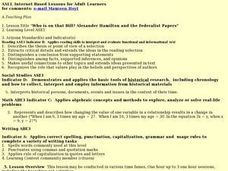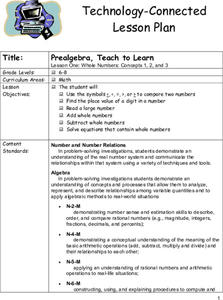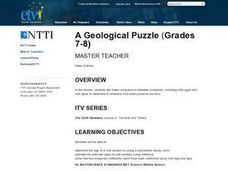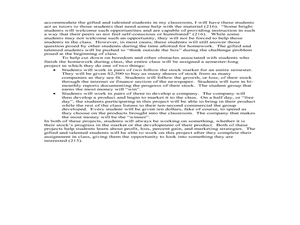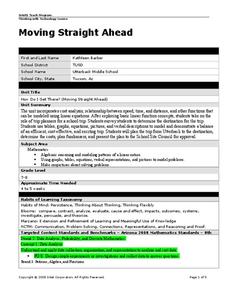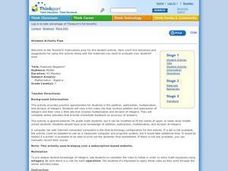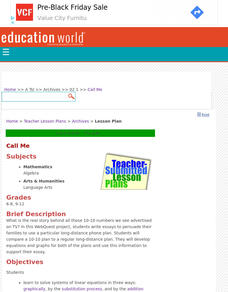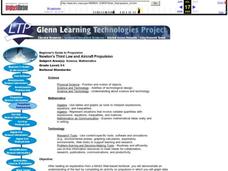Curated OER
Maps and Modes, Finding a Mean Home on the Range
Fifth graders investigate data from maps to solve problems. In this data lesson, 5th graders study maps and collect data from each map. Students present their data in a variety of ways and calculate the mode, mean, median, and range.
Curated OER
Who is on that Bill? Alexander Hamilton and the Federalist Papers
Students, who are adult learners, participate in an Internet scavenger hunt in order to assimilate information about the biography of Alexander Hamilton and the Federalist Papers. They look at the Federalist and Anti-Federalist Papers...
Curated OER
How Alike Are We?
Fourth graders find the range, mode, median, and mean for each of the data sets (height and shoe size). They discuss which measure of central tendency for each data set best represents the class and why. Students graph the shoe size and...
Curated OER
Rise Over Run
High schoolers define the slope of the line, find the slope between any two points on the line, and allow them to name other areas where the slope is used. They explain why the slope is defined as the rise over the run.
Curated OER
Whole Numbers
Student are assigned one of the sections on whole numbers. After reviewing the content, they teach their assigned sections to other class mates. They publish their findings on a PowerPoint slide show to use when they teach their section.
Curated OER
Killer Wrapper
Learners examine the importance of food safety and the impact it has on their lives. In this health lesson students complete an oral report on food poisoning and design a low cost "safe" packing material for bread.
Curated OER
WINDMILL POWER
Learners study operations with real numbers using mental computation or paper-and-pencil calculations. They judge the reasonableness of numerical computations and their results. They set up and solve proportions for direct and inverse...
Curated OER
Magnetic Units of Measurement
In this magnetic circuits worksheet, students answer 16 questions about magnetic flux, resistance, voltage, current, and reluctance.
Curated OER
A Geological Puzzle
Young scholars compare and contrast the various types of rocks on each continent. In groups, the calculate the rock ages and types to determine if the continents, in their opinion, were joined at one time. They develop two imaginary...
Curated OER
Can You See the Music?
Fourth graders examine the makeup of the electromagnetic spectrum and how the various forms of EMRs are similar and different from each other. They, in pairs, solve problems from worksheets imbedded in this lesson plan.
Pennsylvania Department of Education
Extending Pattern Understandings
Students use shapes and manipulatives to demonstrate patterns. In this patterns lesson plan, students also break up patterns to identify a pattern unit.
Curated OER
Integrating Functions
In this math activity, students find the answers to the functions that includes integration and trigonometry. They use the examples for help with the special functions.
Curated OER
Squaring Function of Natural Numbers
Eighth graders complete problems where they use the definition of exponents to expand the squaring function of natural numbers. In this squaring natural numbers lesson plan, 8th graders also identify squares form 0 - 12 and complete a...
Curated OER
Moving Straight Ahead
Young scholars analyze the relationship between speed, time and distance. In this math lesson, students plan a school trip. Young scholars determine the efficiency and cost effectiveness of a trip.
Curated OER
Calibrating a Roverbot
Students build and program a Lego Mindstorms Roverbot to travel for a given amount of time. They gather data on time versus distance traveled to determine a calibration constant for their robot, which relates time to distance.
Curated OER
Fibonacci I
Fifth graders have the opportunity to gather information themselves on Fibonacci and on the occurrence of Fibonacci numbers in nature. They divide up into groups of 2 to 4 to research.
Curated OER
Virtual Field Trip: Lodging and Meals
Students calculate the costs for lodging and meals for a virtual field trip. They calculate the number of nights lodging needed for road and city travel and the number of meals needed, the costs for each, and input the data using...
Curated OER
Positively Negative?
Middle schoolers practice the addition, subtraction, multiplication, and division of integers. They view a video clip on addition and subtraction of integers. Students observe a Web site that reviews multiplication and division of...
Curated OER
The Old Chicken Run Problem
Sixth graders apply problem solving strategies to work with a real life situation in which they need to determine the area. They determine the area of chicken runs that are rectangular in shape when give a partial perimeter.
Curated OER
Square Milk Bottle Crates
Learners attempt a problem that Students has the potential to have more than one solution. Hence the problem is accessible to a wide range of learners. The problem is essentially about finding patterns and this is typical of a number of...
Curated OER
Polygonal Strings
Sixth graders apply knowledge of how to calculate the area and perimeter of triangles. They determine why it is inappropriate to measure the area of land by its perimeter which is done in certain areas of New Guinea. They complete a...
Curated OER
Call Me
Students write essays to persuade their families to use a particular long-distance phone plan. They compare a 10-10 plan to a regular long-distance plan.
Curated OER
Newton's Third Law and Aircraft Propulsion
Learners research propulsion, graph data, and interpret the results.
Curated OER
Introduction to Economics
Students develop the concept of supply and demand. In this economics lesson, students listen to a lecture and take notes on supply and demand. Students create a coherent set of notes about supply and demand.



